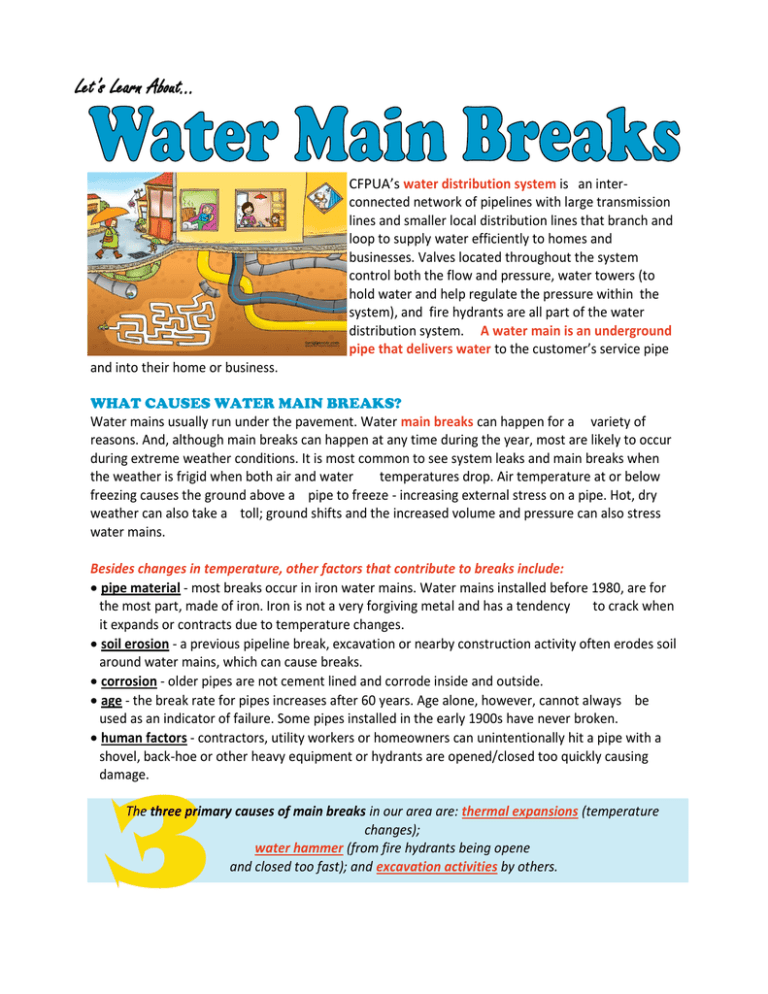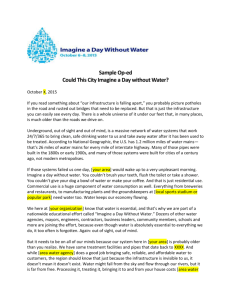Water Main Breaks
advertisement

Let’s Learn About... CFPUA’s water distribution system is an interconnected network of pipelines with large transmission lines and smaller local distribution lines that branch and loop to supply water efficiently to homes and businesses. Valves located throughout the system control both the flow and pressure, water towers (to hold water and help regulate the pressure within the system), and fire hydrants are all part of the water distribution system. A water main is an underground pipe that delivers water to the customer’s service pipe and into their home or business. WHAT CAUSES WATER MAIN BREAKS? Water mains usually run under the pavement. Water main breaks can happen for a variety of reasons. And, although main breaks can happen at any time during the year, most are likely to occur during extreme weather conditions. It is most common to see system leaks and main breaks when the weather is frigid when both air and water temperatures drop. Air temperature at or below freezing causes the ground above a pipe to freeze - increasing external stress on a pipe. Hot, dry weather can also take a toll; ground shifts and the increased volume and pressure can also stress water mains. Besides changes in temperature, other factors that contribute to breaks include: pipe material - most breaks occur in iron water mains. Water mains installed before 1980, are for the most part, made of iron. Iron is not a very forgiving metal and has a tendency to crack when it expands or contracts due to temperature changes. soil erosion - a previous pipeline break, excavation or nearby construction activity often erodes soil around water mains, which can cause breaks. corrosion - older pipes are not cement lined and corrode inside and outside. age - the break rate for pipes increases after 60 years. Age alone, however, cannot always be used as an indicator of failure. Some pipes installed in the early 1900s have never broken. human factors - contractors, utility workers or homeowners can unintentionally hit a pipe with a shovel, back-hoe or other heavy equipment or hydrants are opened/closed too quickly causing damage. 3 The three primary causes of main breaks in our area are: thermal expansions (temperature changes); water hammer (from fire hydrants being opene and closed too fast); and excavation activities by others. IDENTIFYING MAIN BREAKS If a contractor, for example, hits a water line while operating a back-hoe, it will most likely be noticed immediately. On the other hand, if a hole or crack develops in the pipe, it might not be noticed right away. The water will typically find its way to the surface and because the water main is under pressure and water will continue to flow until the break is controlled. To help prevent small leaks from becoming big problems and to reduce water loss in the system know how to identify a potential main break. Here’s what to look for: Water leaking around a metal cap on the ground that has “water” stamped on the top Water leaking out of a fire hydrant nozzle cap Water seeping up out of the ground around a fire hydrant Water seeping up out of the ground or pavement area Your water service line leaking on your property Saturated soil, standing water, and water flow from the water meter Sinkholes or undermined streets or sidewalks If you notice any of these telltale signs, call the CFPUA Emergency Hotline at 332-6565. This is the fastest way to report main breaks and other utility emergencies and get crews dispatched.



